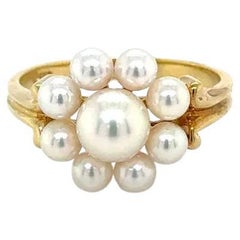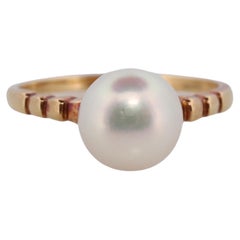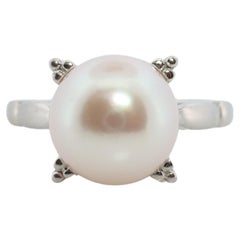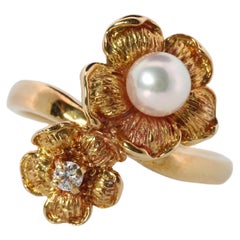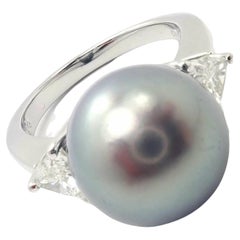Mikimoto Pearl Rings
1990s Modern Engagement Rings
Pearl, Diamond, Platinum, Yellow Gold, 18k Gold, Gold
1990s Modern Engagement Rings
Diamond, Pearl, Gold, 14k Gold, 18k Gold, Yellow Gold, Platinum
Late 20th Century Modernist Cluster Rings
Pearl, Gold, 18k Gold, Yellow Gold
1990s Engagement Rings
Diamond, Pearl, Gold, 14k Gold, 18k Gold, Yellow Gold, Platinum
1990s Modern Engagement Rings
Pearl, Diamond, White Gold, Platinum, 18k Gold, 14k Gold, Gold
1990s Engagement Rings
Diamond, Pearl, Gold, 14k Gold, 18k Gold, Yellow Gold, Platinum
1990s Modern Engagement Rings
Pearl, Coral, Platinum, Yellow Gold, 18k Gold, 14k Gold, Gold
1990s Modern Engagement Rings
Diamond, Pearl, Gold, 14k Gold, 18k Gold, Yellow Gold, Platinum
Early 2000s Japanese Cocktail Rings
Diamond, Pearl, Platinum
2010s Contemporary Cocktail Rings
Diamond, Pearl, 18k Gold
Early 2000s Unknown Contemporary Fashion Rings
Pearl, Yellow Gold
1990s Engagement Rings
Diamond, Pearl, Gold, 14k Gold, 18k Gold, Yellow Gold, Platinum
1990s Engagement Rings
Pearl, Diamond, Platinum, Yellow Gold, 18k Gold, 14k Gold, Gold
1990s Modern Engagement Rings
Diamond, Pearl, Gold, 14k Gold, 18k Gold, Yellow Gold, Platinum
2010s Cocktail Rings
Diamond, Cultured Pearl, Yellow Gold
Vintage 1980s Fashion Rings
Diamond, Pearl, 18k Gold, Yellow Gold
2010s Cocktail Rings
Diamond, Cultured Pearl, White Gold
2010s Fashion Rings
2010s Japanese Cocktail Rings
Diamond, South Sea Pearl, Platinum
2010s Japanese Cocktail Rings
Diamond, South Sea Pearl, Platinum
21st Century and Contemporary Cocktail Rings
Diamond, Pearl, 18k Gold, White Gold
20th Century Engagement Rings
Pearl, Gold, 18k Gold, Yellow Gold
21st Century and Contemporary Unknown Fashion Rings
Diamond, Pearl, 18k Gold, Yellow Gold
Late 20th Century Unknown Modern Cocktail Rings
Diamond, Pearl, Gold, 14k Gold, Yellow Gold
2010s Cocktail Rings
Diamond, South Sea Pearl, 18k Gold, White Gold
21st Century and Contemporary Unknown Cocktail Rings
Diamond, Pearl, Gold, 18k Gold, White Gold
21st Century and Contemporary Japanese Modern Cluster Rings
Diamond, Pearl, 18k Gold, Yellow Gold
21st Century and Contemporary Italian Contemporary Cocktail Rings
Diamond, Pearl, 18k Gold, White Gold
Vintage 1970s Japanese Modernist Cocktail Rings
Pearl, White Diamond, Ruby, Black Pearl, Diamond, 18k Gold, Rhodium, Whi...
2010s American Contemporary Cocktail Rings
Diamond, Pearl, 18k Gold, Yellow Gold
Vintage 1980s Japanese Modernist Cocktail Rings
Pearl, White Diamond, Cultured Pearl, Diamond, 18k Gold, Yellow Gold, Gold
2010s Cluster Rings
2010s Solitaire Rings
20th Century Engagement Rings
White Gold
20th Century Japanese Contemporary Fashion Rings
Black Pearl, Diamond, 18k Gold, White Gold
Early 2000s Contemporary Cluster Rings
Diamond, Natural Pearl, 18k Gold
21st Century and Contemporary Unknown Contemporary Cluster Rings
Cultured Pearl, 14k Gold
Late 20th Century Unknown Artisan Cluster Rings
Cultured Pearl, Ruby, 18k Gold, Yellow Gold
21st Century and Contemporary Cocktail Rings
Diamond, Pearl, 18k Gold, White Gold
Vintage 1960s Japanese Retro Cocktail Rings
Cultured Pearl, Ruby, Pearl, 14k Gold, Gold
Late 20th Century Unknown Contemporary Cocktail Rings
Diamond, Cultured Pearl, 18k Gold, Yellow Gold
Early 2000s Japanese Neoclassical Fashion Rings
Pearl, 18k Gold, Yellow Gold
21st Century and Contemporary Unknown Artisan Band Rings
Cultured Pearl, 18k Gold, Yellow Gold
20th Century Fashion Rings
Pearl, 18k Gold, Yellow Gold
Vintage 1970s Japanese Modernist Fashion Rings
Pearl, 14k Gold, Yellow Gold
Early 2000s Japanese Modern More Rings
Diamond, Pearl, 18k Gold
21st Century and Contemporary Band Rings
Pearl, Yellow Gold, 18k Gold
2010s American Cocktail Rings
Pearl, Sterling Silver
Late 20th Century Unknown More Rings
White Diamond, Black Pearl, Platinum
20th Century Japanese Modern Three-Stone Rings
Cultured Pearl, Gold, Yellow Gold, 18k Gold
21st Century and Contemporary Band Rings
Pearl, Yellow Gold
21st Century and Contemporary Band Rings
Pearl, Yellow Gold
20th Century Japanese Cocktail Rings
Pearl, Diamond, 18k Gold
21st Century and Contemporary Japanese Cocktail Rings
Diamond, Cultured Pearl, Platinum
2010s Japanese Fashion Rings
Diamond, Pearl, Platinum
21st Century and Contemporary Engagement Rings
Diamond, Pearl, 14k Gold, Yellow Gold
Late 20th Century Unknown More Rings
Diamond, Pearl, 18k Gold, Yellow Gold
2010s Japanese Fashion Rings
Diamond, Pearl, Platinum
20th Century Japanese Cocktail Rings
Diamond, Cultured Pearl, 18k Gold
20th Century Contemporary Cocktail Rings
White Diamond, Cultured Pearl, Pearl, Diamond, Yellow Gold, 18k Gold, Gold
- 1
Mikimoto Pearl Rings For Sale on 1stDibs
How Much are Mikimoto Pearl Rings?
Mikimoto for sale on 1stDibs
Born to a noodle-shop owner, Japanese jeweler Kokichi Mikimoto (1858–1954) worked in the seafood business before shifting his focus to pearl cultivation. In 1893, he successfully developed the world’s first cultured pearls with a semispherical specimen. His further experimentation would include black and white South Sea pearls. This development gave Mikimoto a supply of what had once been a notoriously rare natural element and earned him the nickname “The Pearl King.” As he once said, “My dream is to adorn the necks of all women around the world with pearls.”
In 1899 in Tokyo’s Ginza district, Mikimoto opened his first, eponymous store in a white-stone building reminiscent of the color of pearls. He quickly earned a reputation for dazzling designs that blended Japanese craftsmanship and European influence. Mikimoto sent his jewelers to Europe to study the latest trends in jewelry and design; they brought back knowledge of Art Deco and Art Nouveau styles, which were incorporated into designs featuring Mikimoto’s pearls.
But Mikimoto’s creations were not met with enthusiasm by all. In 1921, a London newspaper called the designer’s jewelry “only imitations of real pearls” and claimed the company was “misleading” its customers. It developed into a lawsuit in the French courts, which ruled in Mikimoto’s favor, and raised the jeweler’s global profile.
He also brought his work international acclaim through exhibitions and world’s fairs, including the 1926 Sesquicentennial Exposition in Philadelphia where he unveiled a replica of the Liberty Bell covered with pearls. In 1927, Mikimoto met with Thomas Edison, who gave the jeweler’s invention probably its best compliment: “It is one of the wonders of the world that you were able to culture pearls. . . . This isn’t a cultured pearl, it’s a real pearl.”
Following World War II, Mikimoto opened stores around the world, with locations now in Paris, New York City, Los Angeles and Shanghai. Though its founder died in 1954, the Mikimoto company has continued to build on the legacy he established, producing collections of pearl necklaces and other pearl-centric jewelry that span a wide range of styles.
In 2017, the brand reopened its flagship Tokyo store, tapping architect Hiroshi Naito to design a new glittering facade whose 40,000 tiny glass plates are meant to evoke the movement of the ocean as they catch the light. The place where Mikimoto had his legendary success over a century ago is now known as Mikimoto Pearl Island and includes a museum on his life and pearls. A highlight is the “Boss’s Necklace,” which was the first made by Mikimoto and is the model for all the brand’s classic strands that have followed.
Find Mikimoto pendant necklaces, choker necklaces and a range of other jewelry on 1stDibs.
Why Gold Shines in Jewelry Craftsmanship
Gold is the feel-good metal, the serotonin of jewelry. Wear vintage and antique gold necklaces, watches, gold bracelets or gold rings and you feel happy, you feel dressed, you feel, well, yourself.
Gold, especially yellow gold, with its rich patina and ancient pedigree going back thousands of years, is the steady standby, the well-mannered metal of choice. Any discussion of this lustrous metal comes down to a basic truth: Gold is elementary, my dear. Gold jewelry that couples the mystique of the metal with superb design and craftsmanship achieves the status of an enduring classic. Many luxury houses have given us some of our most treasured and lasting examples of gold jewelry over the years.
Since its founding, in 1837, Tiffany & Co. has built its reputation on its company jewelry as well as its coterie of boutique designers, which has included Jean Schlumberger, Donald Claflin, Angela Cummings and Elsa Peretti. There are numerous gold Tiffany classics worth citing. Some are accented with gemstones, but all stand out for their design and the workmanship displayed.
For the woman who prefers a minimalist look, the Tiffany & Co. twist bangle (thin, slightly ovoid) is stylishly simple. For Cummings devotees, signature pieces feature hard stone inlay, such as her pairs of gold ear clips inlaid with black jade (a play on the classic Chanel black and tan), or bangles whose design recalls ocean waves, with undulating lines of lapis lazuli and mother-of-pearl. And just about any design by the great Jean Schlumberger is by definition a classic.
Even had he eschewed stones and diamonds, Southern-born David Webb would be hailed for the vast arsenal of heavy gold jewelry he designed. Gold, usually hammered or textured in some manner, defines great David Webb jewelry. The self-taught jeweler made very au courant pieces while drawing inspiration from ancient and out-of-the-way sources — East meets West in the commanding gold necklaces made by Webb in the early 1970s. The same could be said for his endlessly varied gold cuffs.
In Europe, many houses have given us gold jewelry that sets the highest standard for excellence, pieces that were highly sought after when they were made and continue to be so.
Numerous designs from Cartier are homages to gold. There are the classic Trinity rings, necklaces and bracelets — trifectas of yellow, white and rose gold. As a testament to the power of love, consider the endurance of the Cartier Love bracelet.
Aldo Cipullo, Cartier’s top in-house designer from the late 1960s into the early ’70s, made history in 1969 with the Love bracelet. Cipullo frequently said that the Love bracelet was born of a sleepless night contemplating a love affair gone wrong and his realization that “the only remnants he possessed of the romance were memories.” He distilled the urge to keep a loved one close into a slim 18-karat gold bangle.
BVLGARI and its coin jewelry, gemme nummarie, hit the jackpot when the line launched in the 1960s. The line has been perennially popular. BVLGARI coin jewelry features ancient Greek and Roman coins embedded in striking gold mounts, usually hung on thick link necklaces of varying lengths. In the 1970s, BVLGARI introduced the Tubogas line, most often made in yellow gold. The Tubogas watches are classics, and then there is the Serpenti, the house's outstanding snake-themed watches and bracelets.
A collection called Monete that incorporated the gold coins is one of several iconic BVLGARI lines that debuted in the 1970s and ’80s, catering to a new generation of empowered women. Just as designers like Halston and Yves Saint Laurent were popularizing fuss-free ready-to-wear fashion for women on the go, BVLGARI offered jewels to be lived in.
Since Van Cleef & Arpels opened its Place Vendôme doors in 1906, collection after collection of jewelry classics have enchanted the public. As predominantly expressed in a honeycomb of gold, there is the Ludo watch and accessories, circa the 1920s, and the golden Zip necklace, 1951, whose ingenious transformation of the traditional zipper was originally proposed by the Duchess of Windsor. Van Cleef's Alhambra, with its Moroccan motif, was introduced in 1968 and from the start its popularity pivoted on royalty and celebrity status. It remains one of VCA’s most popular and collected styles.
Mention must be made of Buccellati, whose name is synonymous with gold so finely spun that it suggests tapestry. The house’s many gold bracelets, typically embellished with a few or many diamonds, signified taste and distinction and are always in favor on the secondary market. Other important mid-20th-century houses known for their gold-themed jewelry include Hermès and Ilias Lalaounis.
Find a stunning collection of vintage and antique gold jewelry on 1stDibs.
Finding the Right Rings for You
Antique and vintage rings have long held a special place in the hearts of fine jewelry lovers all over the world.
No matter their origin or specific characteristics, rings are timeless, versatile accessories. They’ve carried deep meaning since at least the Middle Ages, when diamond rings symbolized strength and other kinds of rings were worn to signify romantic feelings or to denote an affiliation with a religious order. Rings have also forever been emblematic of eternity.
Over time, rings have frequently taken the form of serpents, which have long been associated with eternal life, health and renewal. Italian luxury jewelry house Bulgari has become famous for its widely loved Serpenti motif, for example, and its Serpenti ring, like the other accessories in the collection, began as an homage to jewelry of the Roman and Hellenistic eras. The serpent is now a popular motif in fine jewelry. Jewelry devotees have long pined for rings adorned with reptiles, thanks to antique Victorian rings — well, specifically, Queen Victoria’s illustrious engagement ring, which took the form of a gold snake set with rubies, diamonds and an emerald (her birthstone). Designs for Victorian-era engagement rings often featured repoussé work and chasing, in which patterns are hammered into the metal.
Engagement rings, which are reliably intimidating to shop for, are still widely recognized as symbols of love and commitment. On 1stDibs, a range of buying guides can be found for those in the market for antique engagement rings, vintage engagement rings or Art Deco engagement rings.
The most collectible antique engagement rings and vintage engagement rings are those from the Victorian, Edwardian and Art Deco eras. Named for the monarchies of the four King Georges, who in succession ruled England starting in 1714 (plus King William’s reign), antique Georgian rings, be they engagement rings or otherwise, are also coveted by collectors. Pearls, along with colored gemstones like garnets, rubies and sapphires, were widely used in Georgian jewelry. The late-1700s paste jewelry was a predecessor to what we now call fashion or costume jewelry.
The Art Nouveau movement (1880–1910) brought with it rings inspired by the natural world. Antique Art Nouveau rings might feature depictions of winged insects and fauna as well as women, who were simultaneously eroticized and romanticized, frequently with long flowing hair. Art Deco jewelry, on the other hand, which originated during the 1920s and ’30s, is by and large “white jewelry.” White metals, primarily platinum, were favored over yellow gold in the design of antique Art Deco rings and other accessories as well as geometric motifs, with women drawn to the era’s dazzling cocktail rings in particular.
Whether you’re hunting down a chunky classic for a Prohibition-themed cocktail party or seeking a clean contemporary design to complement your casual ensemble, find an exquisite collection of antique, new and vintage rings on 1stDibs.
- Are Mikimoto pearls Akoya?2 Answers1stDibs ExpertAugust 17, 2021No, not all Mikimoto pearls are Akoya. Mikimoto also uses Black South Sea cultured pearls, White South Sea cultured pearls, Golden South Sea cultured pearls, and Conch pearls to create their jewelry. Shop Mikimoto Akoya pearl jewelry on 1stDibs.1stDibs ExpertMarch 22, 2022Yes, Mikimoto pearls are Akoya, meaning they come from Akoya oysters. The brand largely pioneered the production of cultured pearls, which are genuine pearls developed with human assistance. Mikimoto creates Akoya pearl necklaces, pendants, earrings, bracelets, rings and brooches. On 1stDibs, shop a variety of Mikimoto pearl jewelry.
- 1stDibs ExpertOctober 12, 2021How much a Mikimoto pearl necklace is worth will depend on the size of the strand, the number of pearls used and the design. It could range from $920 to $21,000, with a wide variety of price points in between. From pendant and choker to multi-strand and rope versions, find Mikimoto pearl necklaces on 1stDibs.
- 1stDibs ExpertMarch 22, 2022Yes, Mikimoto pearls tend to at least hold their value over time. In some cases, the value of the brand's pearl jewelry increases over time due to demand and the effects of inflation. Keep in mind that the value of any piece of jewelry depends on its condition. Properly storing and caring for your pieces can help to ensure that they retain their value for years to come. On 1stDibs, shop a selection of Mikimoto pearl jewelry.


